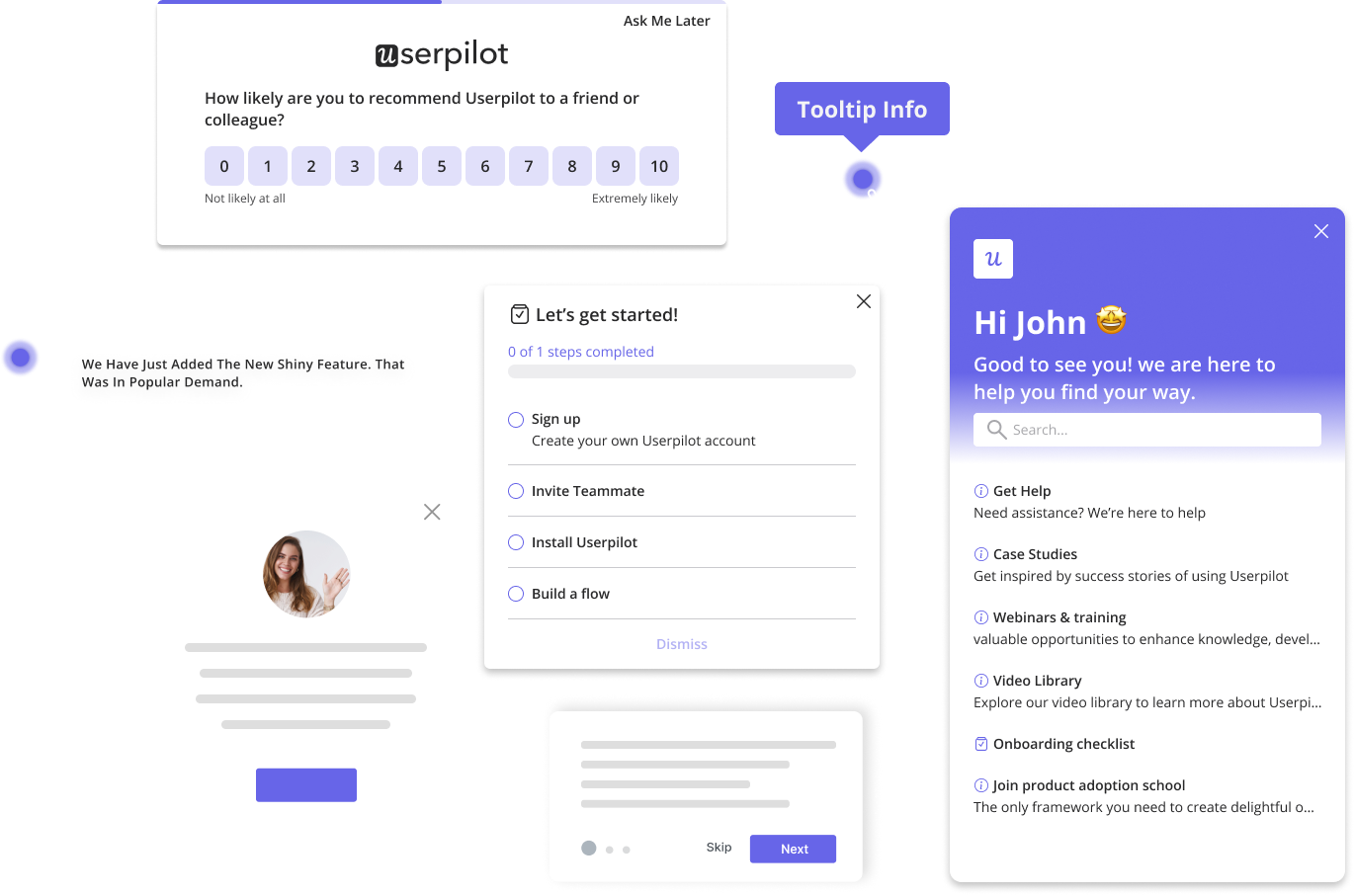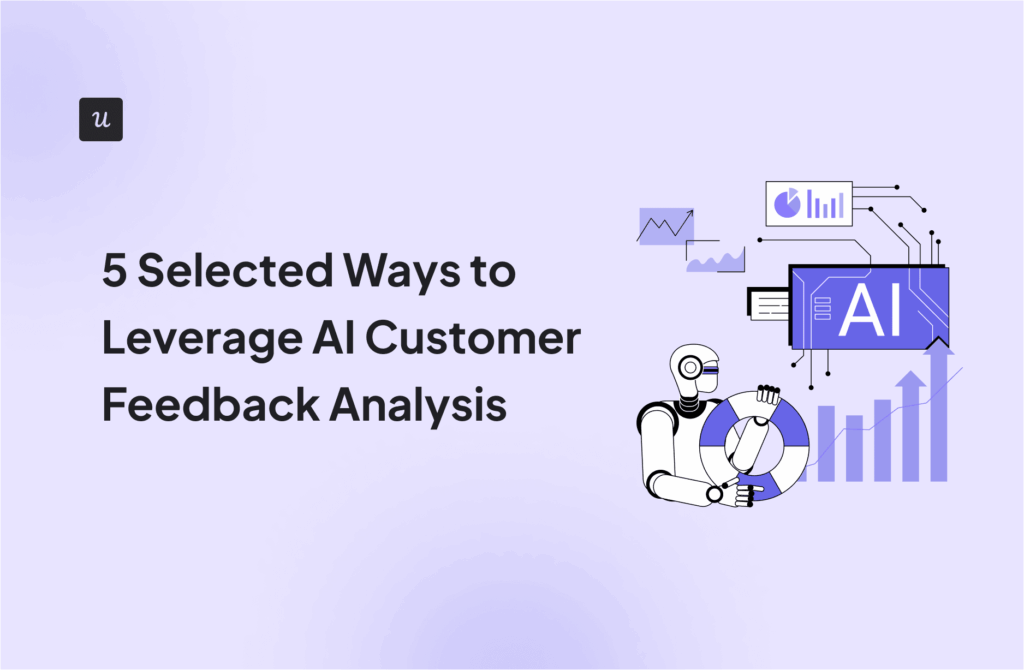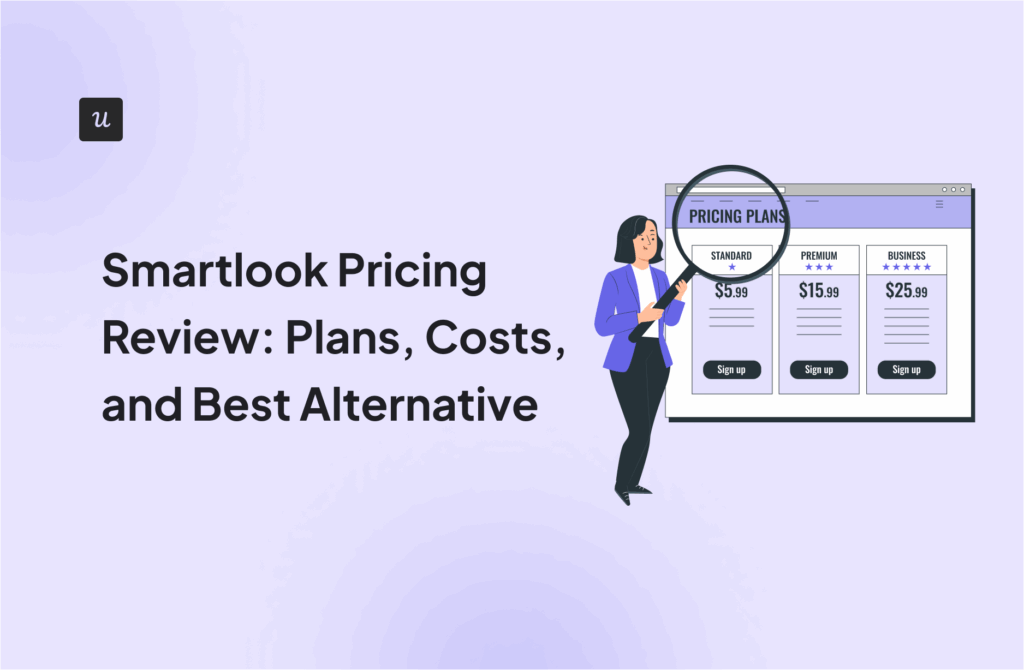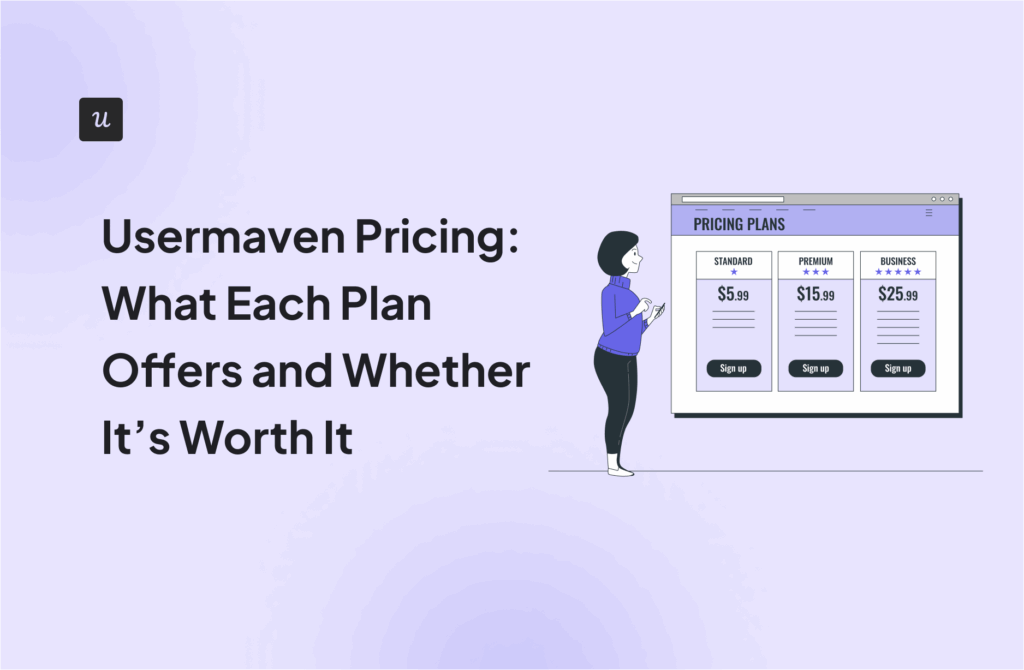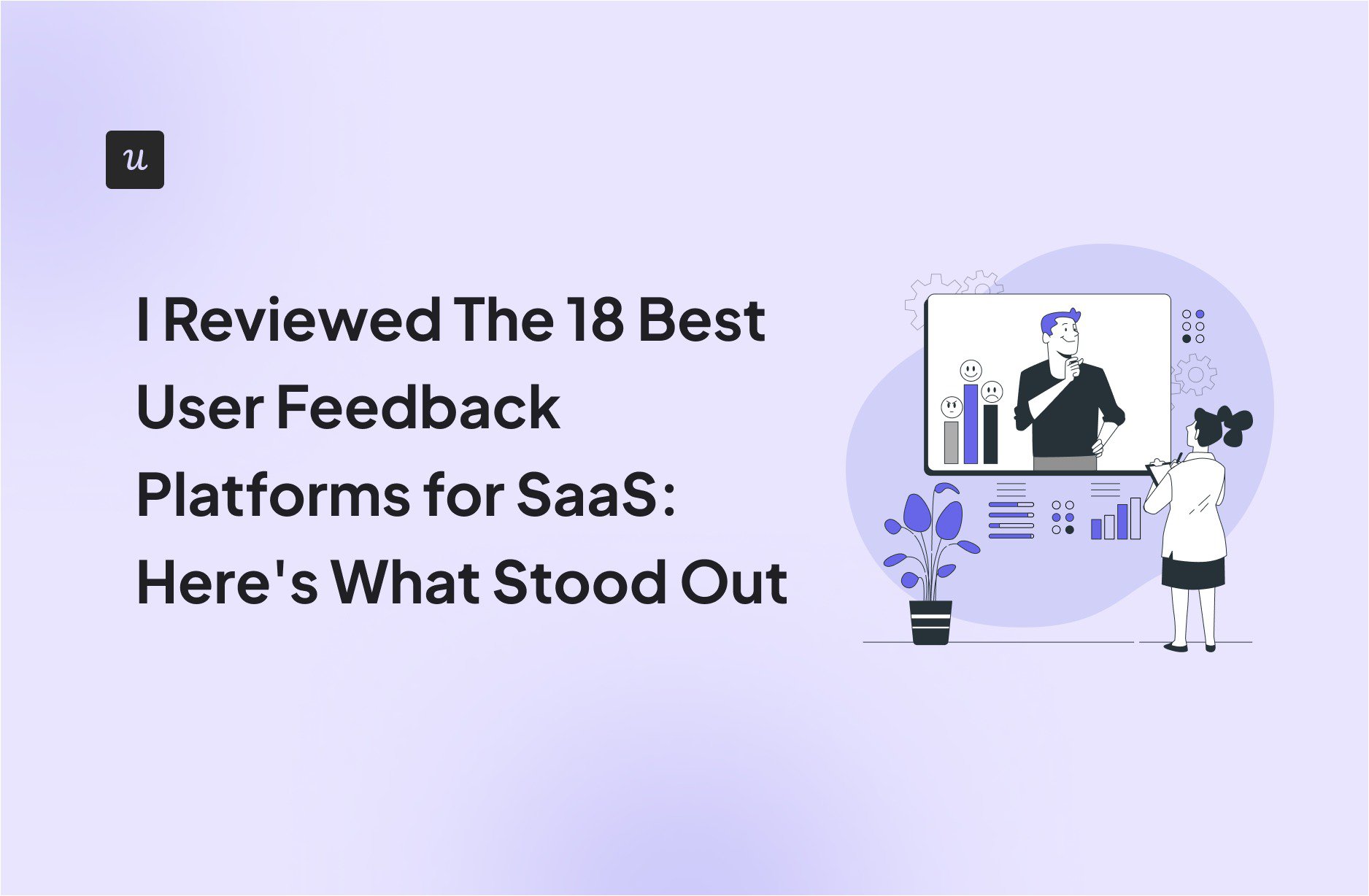
I Reviewed The 18 Best User Feedback Platforms for SaaS: Here’s What Stood Out
Ever tried to manage user feedback across multiple tools, emails, and Slack threads? You know how chaotic it can get: pulling data from your NPS surveys, chasing feature requests sitting in support tickets, not to mention three Slack channels with feedback forwarded by other team members.
These data siloes cost organizations more than you can imagine. Companies report drops in employee productivity and morale, and 31% of participants in a Forrester study even reported a decrease in business revenue.
But with a customer feedback platform, things get much easier.
A customer feedback platform is a centralized solution for collecting, organizing, and analyzing feedback from real users. This way, product teams can make smarter, data-driven decisions.
In this guide, we’ll break down 18 of the best user feedback platforms, grouped by use case. You’ll also learn what to look for in a solution that fits your workflow, so you can turn raw feedback into actionable insights and make product decisions with confidence.
What’s your biggest challenge with user feedback right now?
Understanding your main pain point helps identify the right type of user feedback platform for your needs.
How mature is your current feedback process?
This will help determine if you need a foundational system or a more advanced user feedback platform.
What kind of in-app feedback is most important to you?
A good user feedback platform can capture both quantitative and qualitative data.
Is sharing your roadmap publicly with users a key goal?
Transparency can be a powerful way to build customer loyalty with your user feedback platform.
What’s your main focus for user testing?
Qualitative insights are crucial. The right user feedback platform can facilitate this.
You need an all-in-one user feedback platform.
Your biggest challenge is centralizing feedback from multiple sources. An all-in-one platform like Userpilot consolidates survey responses, feature requests, and analytics into a single source of truth. This ends the chaos and empowers your product team to make data-driven decisions with clarity.
You need a platform with strong in-app survey & microfeedback tools.
Your goal is to capture insights directly within your product. A powerful user feedback platform like Userpilot allows you to trigger contextual NPS, CSAT, and custom surveys based on user behavior. This gets you high-quality, actionable feedback at the exact moment it matters most, without disrupting the user experience.
You need a user feedback platform with feature request & roadmap capabilities.
You’re struggling to manage and prioritize user ideas. A platform like Userpilot helps you not only collect feature requests but also analyze them alongside user behavior data. This allows you to move beyond simple voting and prioritize the features that will truly drive growth and retention.
You need a user feedback platform that supports deep user testing insights.
You need to uncover the ‘why’ behind user actions. While dedicated testing tools are great, an all-in-one user feedback platform like Userpilot integrates qualitative feedback with quantitative data and session replays. This gives you a holistic view of the user experience, helping you validate ideas and identify friction points faster.
Try Userpilot Now
See Why 1,000+ Teams Choose Userpilot
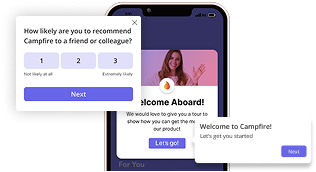
What are the different types of user feedback tools?
Depending on your goals, whether you need to collect feedback, manage feature requests, or run user tests, choosing the right tool type matters.
Here are the five main categories I recommend you explore:
1. All-in-one feedback tools
These platforms combine several feedback methods, like surveys, feature request boards, and analytics, into a single workflow. They help product teams manage feedback end-to-end, from collection to prioritization.
🔍 Example use case: You’re a SaaS company preparing to launch a major product update. You’re using an all-in-one platform, like Userpilot, to centralize customer feedback management across multiple touchpoints (like in-app survey responses, NPS trends monitoring, or feature request collection). This will help your product team manage requests more easily and prioritize new features without juggling five different tools.
2. In-app survey and microfeedback tools
These tools let you capture instant feedback within your app through modals, tooltips, or microsurveys. They’re great for measuring customer satisfaction or gathering actionable user feedback at the right moment.
🔍 Example use case: You’re a B2B analytics platform that wants in-app surveys to ask, “Was this helpful?” right after a user explores a new dashboard feature. Your product team will get fast, ready-to-use learnings without interrupting the user experience.
3. Feature request and roadmap platforms
Focused on capturing and prioritizing feature requests, these tools often include public roadmaps to keep users in the loop. They close the feedback loop and improve transparency.
🔍 Example use case: You’re a sales intelligence SaaS startup that wants a voting board instead of juggling a bunch of feature requests in messy spreadsheets. You can launch a public voting board where users can submit ideas like “Dark mode” or “Bulk editing,” upvote their favorites, and track progress. Now, your team knows exactly what matters most to users, roadmap planning becomes data-driven, and your power users feel heard and valued.
4. User interview and testing tools
These platforms facilitate user interviews, usability tests, and idea validation sessions. They give you context behind the numbers and data-driven takeaways you can’t get from surveys alone.
🔍 Example use case: You’re a mid-sized fintech company that wants to learn how small business owners interact with their payment dashboard before rolling out a major redesign. Instead of guessing, you run remote usability tests with small business owners to see where they struggle, like finding transaction history or understanding fee breakdowns. These learnings then guide how you modify the layout, improve navigation, and make sure the final design reduces friction and improves conversions.
5. Review and social listening platforms
These tools track customer feedback from public sources like review sites, social media, and communities. They’re essential for understanding brand perception and identifying improvement opportunities outside your app.
🔍 Example use case: You’re a fast-growing HR tech startup. With a social listening tool, you can track brand mentions on LinkedIn and review sites in real time. When recurring complaints pop up (like confusing onboarding steps), you can flag them and share with your product team to simplify the flow. This insight can also help your marketing team adjust messaging, so user expectations match the actual experience.
Key features to look for in user feedback platforms
Having a nice dashboard makes the experience enjoyable, but choosing the best feedback tools for your team should check some other boxes, too.
You need to be able to collect and organize customer feedback efficiently, regularly, and proactively instead of always scrambling to put out fires. To avoid this and keep all data organized in one place and available for your product, marketing, and sales teams, you need a tool that’s a meaningful update to your tech stack.
To make the right call, I’d focus on these six practical functionalities:
| Feature | Why it matters |
|---|---|
| Multiple feedback channels | Lets you collect feedback through surveys, in-app widgets, NPS, and more. |
| Segmentation and targeting | Ensures feedback comes from the right users by segmenting based on behavior, lifecycle stage, or demographics. |
| Analytics and reporting | Turns raw feedback into learnings with trends, sentiment analysis, and prioritization tools. |
| Integrations and workflows | Connects with your product, CRM, and dev tools, making it easy to close the feedback loop and act on findings. |
| User-friendly interface | Allows product managers and non-tech teams to manage feedback without the need for coding. |
| Scalability | Adapts to your growth, whether you’re a 10-person SaaS startup or an enterprise product team. |
💡 Pro tip: When evaluating platforms, look for features that match your workflows, whether that’s triaging support tickets, planning sprint cycles, or prioritizing roadmap items. The goal is to collect and route feedback to the right person within your organization, so you can really act on it to drive retention and growth. That’s exactly what the best tools help you do.
The 18 best user feedback platforms for SaaS
I compiled a list of 18 top user feedback platforms, grouped by use case to help you choose the right tool for your SaaS business. For each tool, you’ll find its ideal audience, standout features, pros and cons, pricing, and why it might (or might not!) be the best fit for your team.
I. All-in-one user feedback collection tools
All-in-one feedback platforms help collect, analyze, and act on feedback across multiple channels from one place. These channels include:
- NPS (Net Promoter Score) survey responses
- Feature requests
- Interviews
- Churn surveys, etc.
Here are my top picks from this category:
1. Userpilot: Best all-in-one user feedback tool for SaaS businesses
Best for: SaaS companies that want a holistic approach to collecting and analyzing actionable user feedback, so product managers can reliably test ideas, monitor campaign performance, and uncover powerful insights.
(Yes, this is our own tool, but we built it because existing feedback solutions left too many gaps. And frankly, it ticks all the boxes you need to actively manage feedback, improve customer satisfaction, and turn data into action items for better decisions.)
| Overall Userpilot G2 rating | 4.6/5⭐️ |
|---|
Userpilot is a product growth and user feedback platform built for SaaS companies that want to gather feedback with more than just surveys. The tool helps collect actionable feedback at every stage of the user journey and combines in-app feedback, segmentation, and analytics in one platform. Product managers get a clear path from feedback to outcomes, with no requirements to write any code.
Standout features:
Multiple user feedback channels: Userpilot lets you collect feedback where it matters: inside your product. You can use:
- In-app surveys: NPS, CSAT, CES, and custom formats to measure customer satisfaction without relying on emails.
- Behavior-triggered microsurveys: Ask for feedback at key touchpoints (such as after using a new feature) to validate adoption and usability.
- UI patterns: Use slideouts, banners, tooltips, and modals for quick or passive feedback to gather data-driven observations without disrupting the experience.
- Custom event targeting: Trigger feedback when users take (or skip) critical actions, ensuring you only ask questions that drive meaningful decisions.

Behavior-based segmentation: Go beyond generic surveys and target the right audience at the right time, segmenting them by:
- Persona: Target new users, power users, or churn risks to understand needs across different segments.
- Lifecycle stage: Collect context-specific insights during onboarding, post-activation, or pre-renewal to reduce friction.
- Product usage: Identify opportunities like “Completed Feature X” or “Skipped Onboarding” to fine-tune adoption flows.

Unified analytics: Userpilot connects feedback data with product usage analytics, so you can analyze:
- Response breakdowns: Segment feedback by lifecycle stage, behavior, or persona to pinpoint friction and improvement opportunities.
- NPS trends + adoption data: See survey results and feature usage in one dashboard to measure the impact of product changes.
- Journey outcomes: Tie feedback directly to activation and retention metrics to prioritize improvements that affect growth.
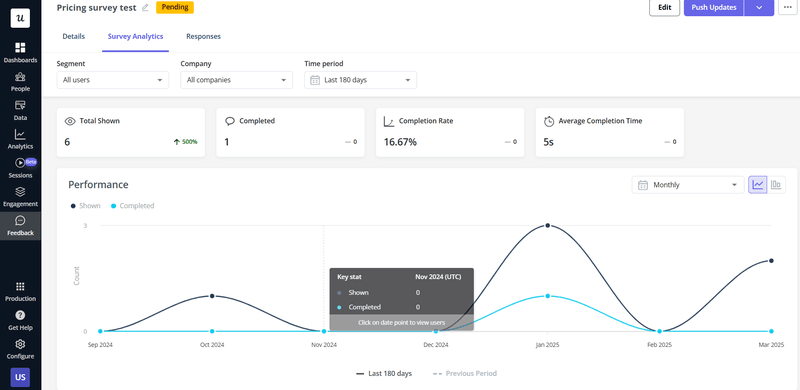
AI-powered localization: Automatically translate the surveys for users around the globe to increase user engagement. This is critical because most users prefer reading in their own language: websites with multi-language content have seen a 55% jump in conversions compared to English-only websites, according to a study.
That’s because localization is that final touch that says, “We care about you” to users.
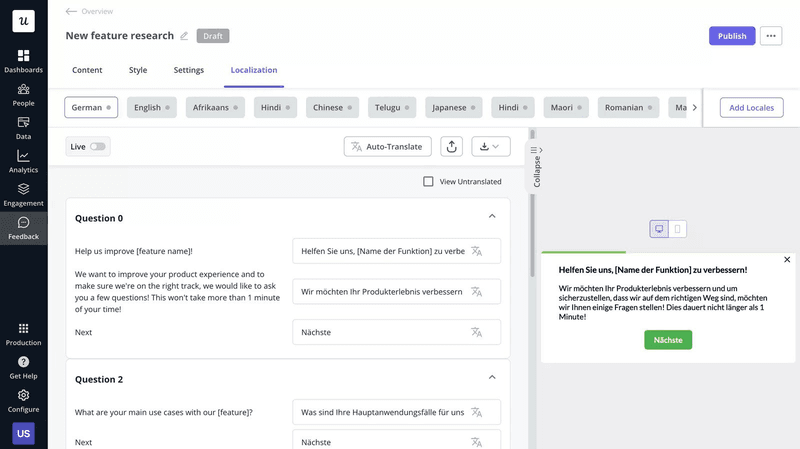
User-friendly interface: Designed for non-technical teams, so product managers and marketers can move fast with an all-in-one no-code workspace:
- No-code survey and UI element builder: Create surveys and in-app prompts in minutes to reduce time-to-market for feedback campaigns.
- Visual journey editor: Schedule and trigger feedback at the right moment to capture contextual insights based on where the user currently is in the flow.
- Built-in expert templates: Use pre-designed NPS, onboarding, and feature validation templates to start collecting actionable feedback immediately without guesswork, or build and save your own templates to standardize creation.
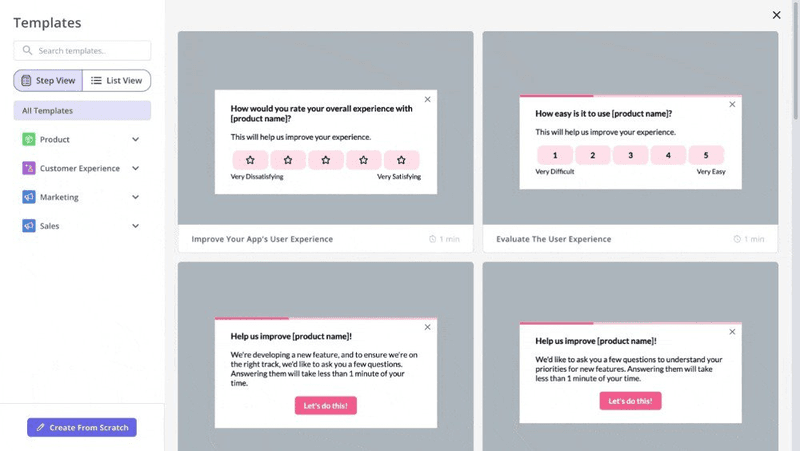
Integrations and workflows: Close the feedback loop faster with a tech stack that works well together:
- CRM tools (HubSpot, Salesforce).
- Analytics platforms (Mixpanel, Amplitude, Segment, Heap).
- Collaboration tools (Slack, Microsoft Teams, Zapier for flexible workflows).
- Data sync with custom webhooks or public API.
Pros:
- Puts feedback collection, segmentation, and customer analytics together in one platform (no duct tape needed!).
- Deep contextual targeting means you gather better-quality feedback.
- Native analytics lets you connect feedback to product decisions without exporting data.
- Easy for non-technical teams to implement and iterate.
Cons:
- Best suited for SaaS with active product usage, like project management tools or CRMs, not ideal for static websites where user interaction is minimal.
- Not ideal for very early-stage startups.
Userpilot pricing:
- Starter: $299/month
- Growth: Custom pricing available.
- Enterprise: Custom pricing available; reach out to us to get a demo!
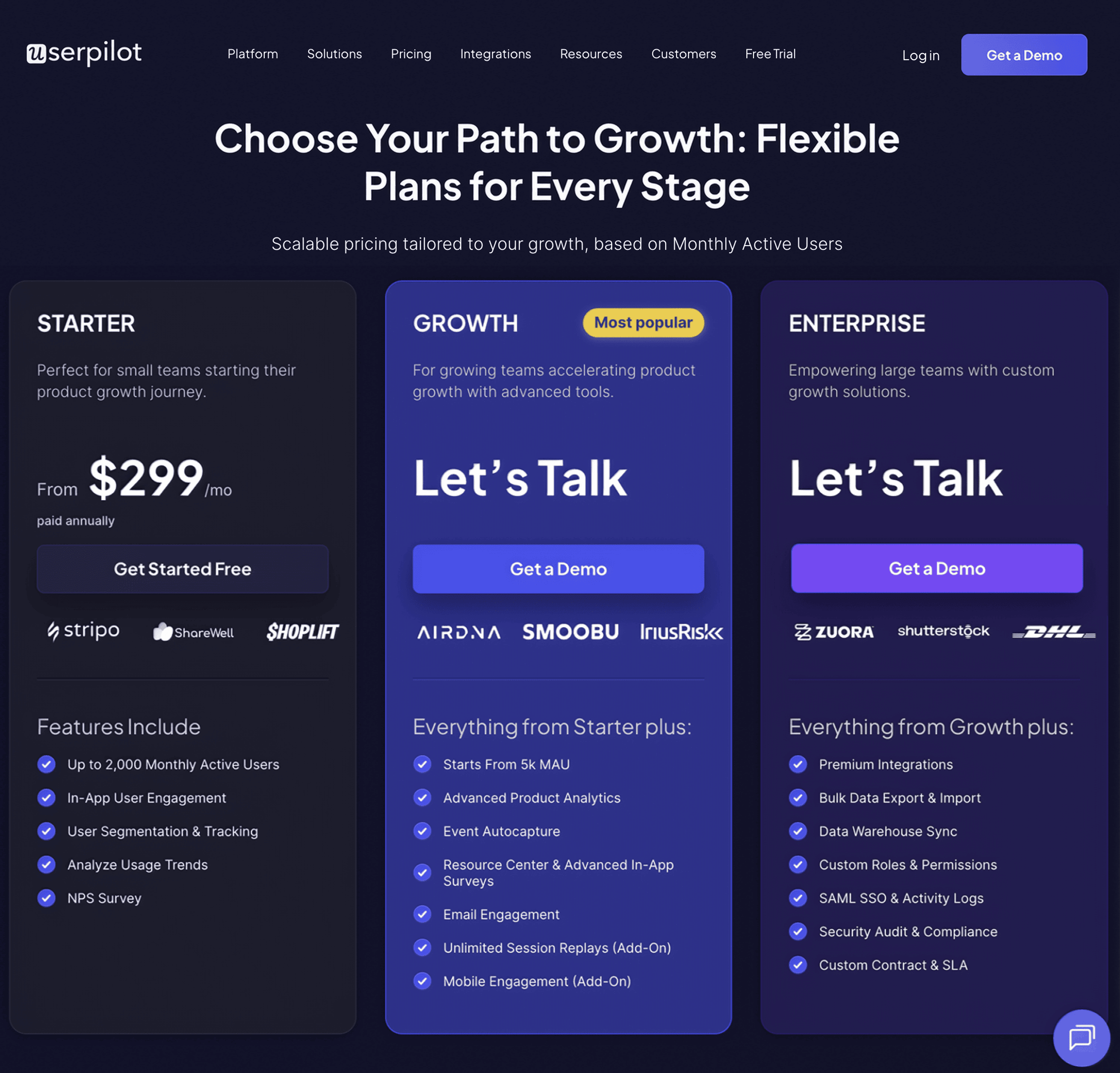
2. Refiner: Best for in-app microsurveys
Best for: Small to mid-market SaaS companies that need targeted NPS, CSAT, CES, or product-market-fit surveys.
| Overall Refiner G2 rating | 4.6/5⭐️ |
|---|
Refiner is a specialized in-product survey tool for web and mobile apps. It lets you run highly-targeted surveys and microsurveys to get contextual feedback and segment responses by user behavior.

Standout features:
- Drag-and-drop customizable microsurveys (in-app, web, email).
- Precise customer segmentation via CDP/Segment integration for targeted prompts.
- Real-time dashboards with NPS/CSAT/CES trends and sentiment tagging.
Pros:
- Quick, intuitive setup that different teams across the org can easily use.
- Tight integrations (Slack, Segment, Mixpanel) bring survey data into your stack.
Cons:
- Limited support for complex logic in branching.
- Dashboard designer offers less customization than some competitors.
Pricing:
- Essentials: $99/month for 5,000 MAUs.
- Growth: $239/month for 5,000 MAUs but with additional features.
- Enterprise: To get a quote, you need to contact sales.
- *You can get 17% off when billed annually.
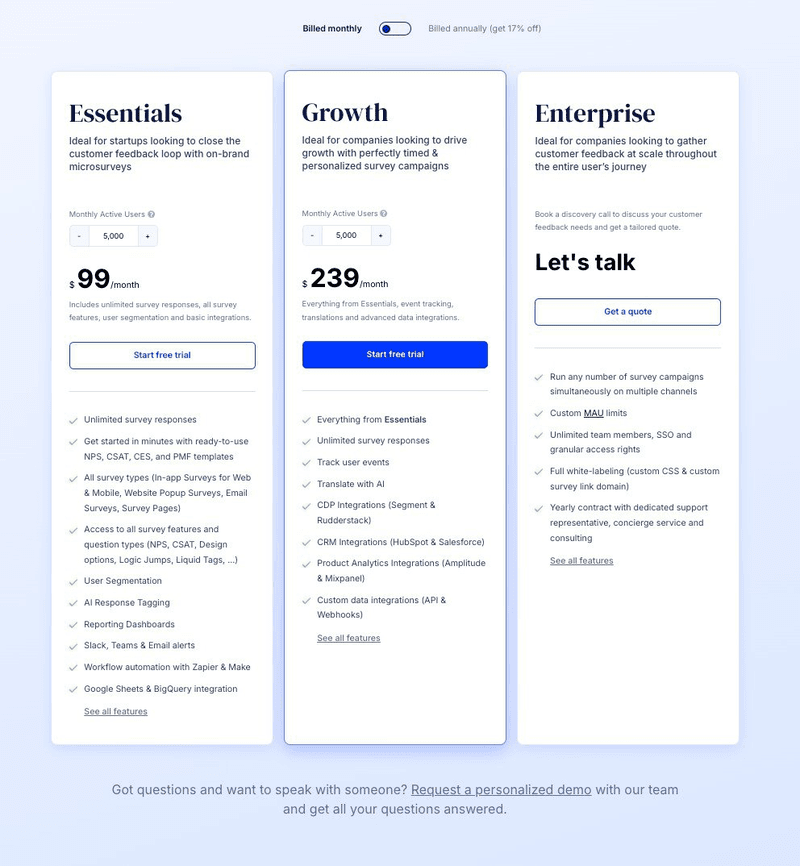
3. Zonka Feedback: Best for multi-channel feedback collection
Best for: Small to mid-sized SaaS companies that need to collect NPS, CSAT, and CES feedback across multiple channels, not just in-app.
| Overall Zonka Feedback G2 rating | 4.6/5⭐️ |
|---|
Zonka Feedback is a multi-channel customer feedback platform that lets businesses collect NPS, CSAT, and CES surveys across web, in-app, email, SMS, and offline touchpoints.
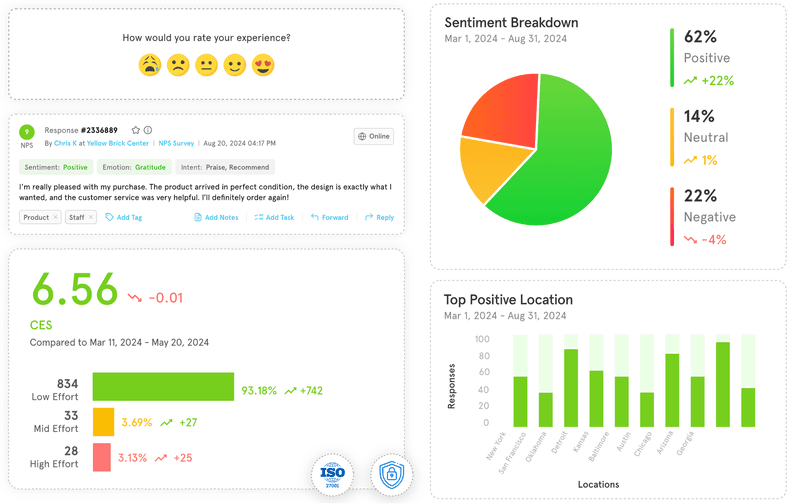
Standout features:
- Multilingual, white-label survey builder with 40+ question types.
- Runs on web, email, SMS, mobile apps, and even kiosks.
- Real-time alerts via Slack and collaborative inbox for feedback management.
Pros:
- Flexible multi-channel feedback collection.
- Highly customizable surveys with offline support.
Cons:
- Users have reported software instability and call issues.
- Advanced reporting requires higher-tier plans.
Pricing:
- Free: up to 50 responses per month
- Starter: $49/month
- Professional: $99/month
- Growth: $199/month
- Enterprise: Custom pricing available

4. Survicate: Best for targeted in-app and web surveys
Best for: SaaS startups and mid-market companies looking for advanced behavioral targeting for NPS, CSAT, and product feedback surveys across web and email.
| Overall Survicate G2 rating | 4.6/5⭐️ |
|---|
Survicate combines in-app microsurveys with web and email feedback to help SaaS teams gather actionable takeaways at the right time. It offers rich targeting options and analytics without building complex workflows from scratch.
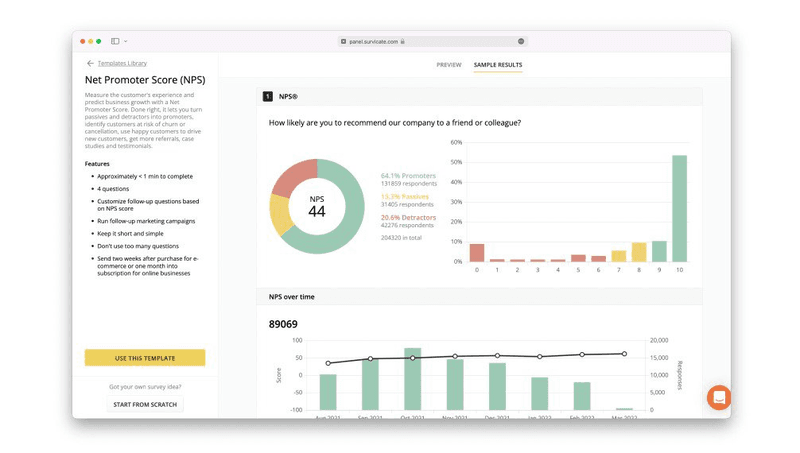
Standout features:
- Multichannel surveys: in-app, web widgets, and email campaigns.
- Advanced segmentation based on user behavior, properties, and UTM tags.
- AI-driven reporting and sentiment analysis in a central dashboard.
Pros:
- Simple, no-code survey builder for quick deployment.
- Broad range of integrations (HubSpot, Intercom, Slack, and CRMs).
Cons:
- Somewhat limited dashboard customization.
- Complex segmentation logic can be challenging for beginners.
Pricing:
- 3 essential plans: Free ($0), Starter ($79), Growth ($49)
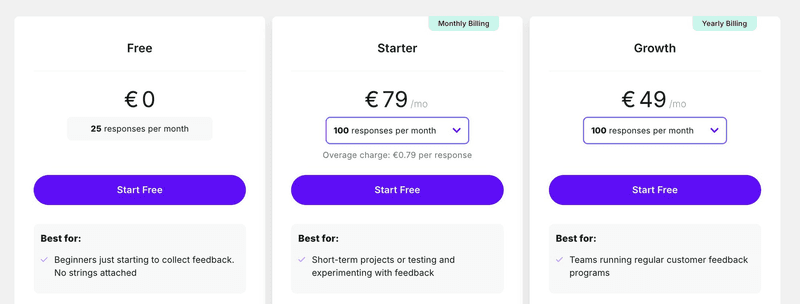
- 3 advanced plans: Volume ($299), Pro ($299 – different feature set), Enterprise ($499)
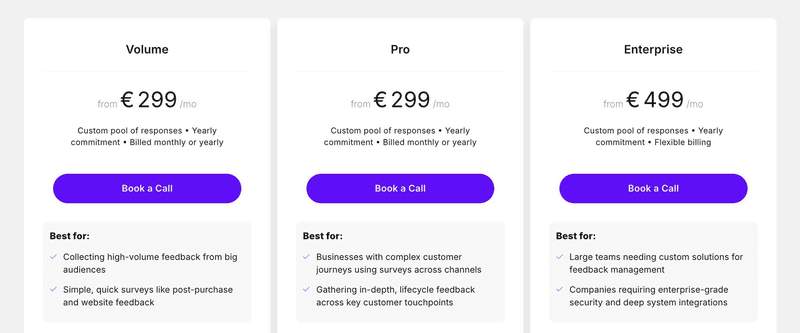
II. In-app survey and microfeedback tools
These tools collect contextual feedback directly inside your product using widgets, tooltips, or embedded microsurveys. Here are my favorite tools from this category:
5. Chameleon: Best for in-app guidance and feedback prompts
Best for: Mid-sized SaaS companies that want to combine in-app user onboarding flows with contextual microfeedback to improve adoption and engagement.
| Overall Chameleon G2 rating | 4.4/5⭐️ |
|---|
Chameleon is an in-product experience platform that helps you guide users through onboarding and improve product adoption. It comes with in-app tours, tooltips, and surveys, which drive feature discovery and capture strategic takeaways without interrupting the user.
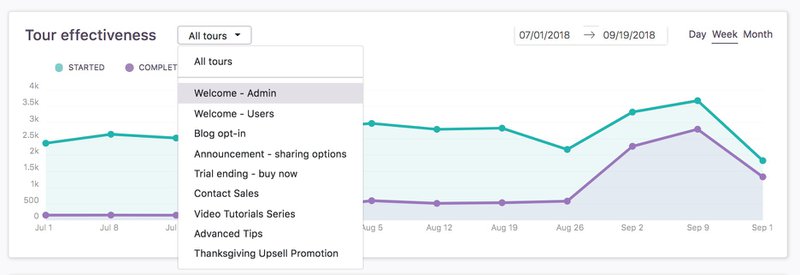
Standout features:
- No-code builder for in-app tours, tooltips, and checklists.
- Embedded NPS and CSAT microsurveys during onboarding or feature launches.
- Segmentation and targeting based on product usage, lifecycle stage, or user properties.
Pros:
- Excellent for teams that prioritize feature adoption and onboarding personalization.
- Flexible UI customization options.
Cons:
- Pricing may be steep for early-stage startups.
- Limited advanced analytics.
Pricing:
- Free plan: with limited features
- Startup: $279/month
- Growth: $12,000/month
- Enterprise: Custom pricing for unlimited seats
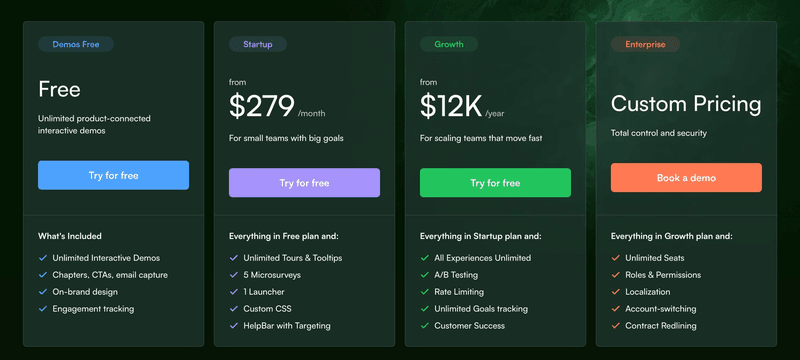
6. Pendo: Best for enterprise analytics and feedback at scale
Best for: Enterprise SaaS companies that need deep analytics, feature usage tracking, and feedback collection in one system for large-scale product operations.
Pendo is a product experience platform that combines in-app messaging, analytics, and feedback to give teams a full view of customer behavior. It helps you understand what users do, gather feedback on why they do it, and then use that information to drive engagement and customer retention.

Standout features:
- Feature usage and path analytics integrated with feedback prompts.
- In-app guides and surveys for NPS, CES, and product validation.
- Prioritization dashboards for feedback and feature requests.
Pros:
- Detailed analytics for data-driven decision-making.
- Scales easily for large organizations.
Cons:
- Steep learning curve for non-technical teams.
- One of the most expensive options in this list, based on multiple G2 reviews.
Pricing:
Prices for the four plans are not displayed publicly on the website. Reach out to sales for more information.
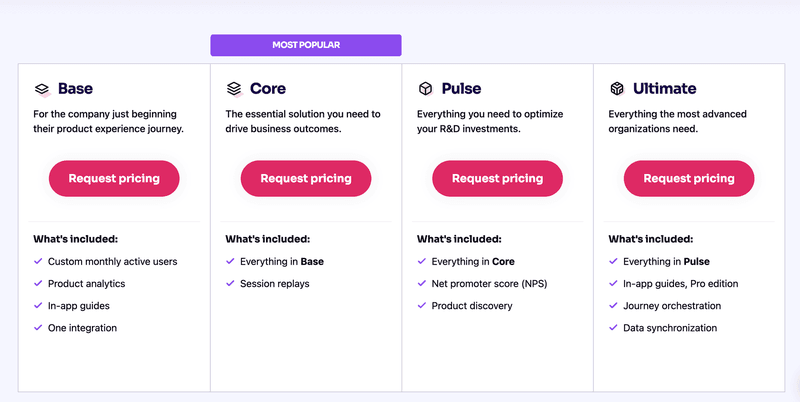
7. Appcues: Best for no-code onboarding and feedback
Best for: SaaS SMBs and mid-market companies that want beautiful onboarding flows and lightweight in-app surveys without developer support.
| Overall Appcues G2 rating | 4.6/5⭐️ |
|---|
Appcues is a no-code platform for creating product tours, checklists, and in-app surveys to improve adoption and retention. Marketing and product teams rely on Appcues to launch personalized onboarding flows while capturing real-time user feedback.
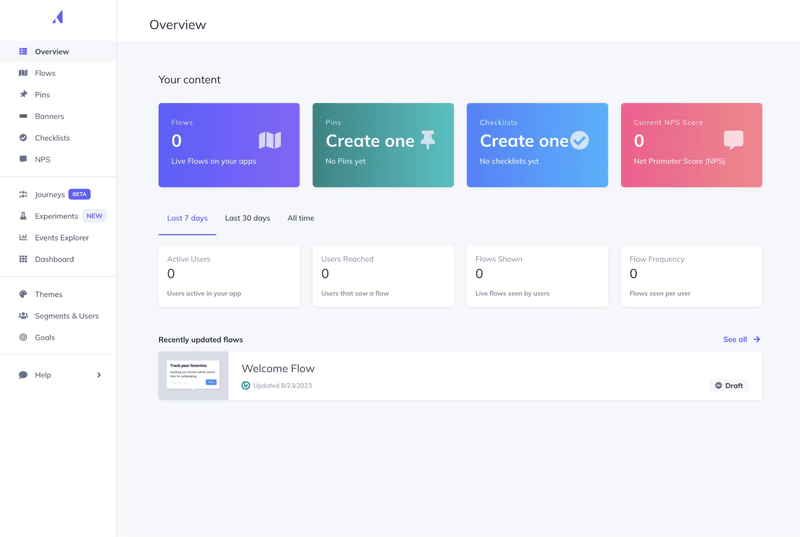
Standout features:
- Drag-and-drop builder for onboarding flows and tooltips.
- Built-in NPS and microfeedback widgets.
- Targeting rules based on user attributes and product behavior.
Pros:
- Fast implementation with minimal tech support required.
- Great for design-driven teams that appreciate polished UI.
Cons:
- Pricing scales quickly with user growth (the price doubles for 5+ users).
- Lacks advanced analytics for feedback trends.
Pricing:
- Start: $300/month
- Grow: $750/month
- Enterprise: Custom pricing
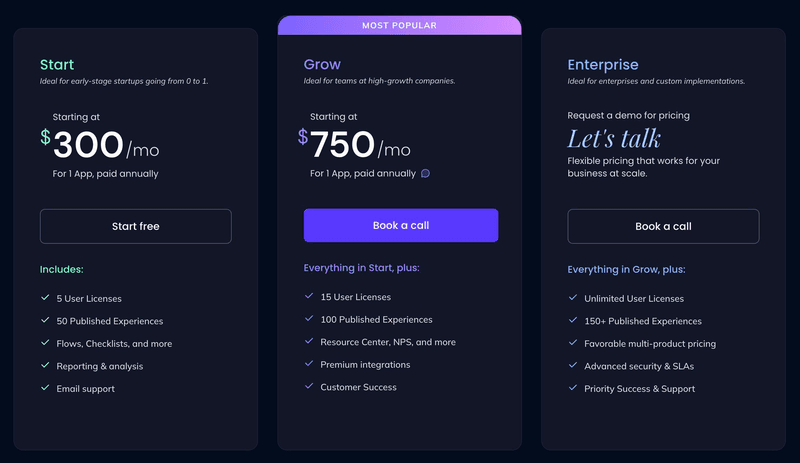
💡 Editor’s note: These three tools all focus on in-app experiences with feedback options, but they’re not the same:
- Chameleon is your go-to if you want lightweight tours and targeted microfeedback without committing to a massive suite.
- Appcues shines when onboarding and adoption are your main goals and you need polished UI patterns.
- Pendo is best for enterprise teams that want product analytics, feedback, and guidance under one roof.
8. Hotjar: Best for visual feedback + behavior insights
Best for: SaaS teams that want qualitative insights into user behavior combined with quick feedback collection via polls and widgets.
| Overall Hotjar G2 rating | 4.3/5⭐️ |
|---|
Hotjar is a well-known feedback tool that offers heatmaps, session recordings, and lightweight widgets and on-page surveys to capture user sentiment. It lets teams see what users do and understand why they do it through visual analytics.
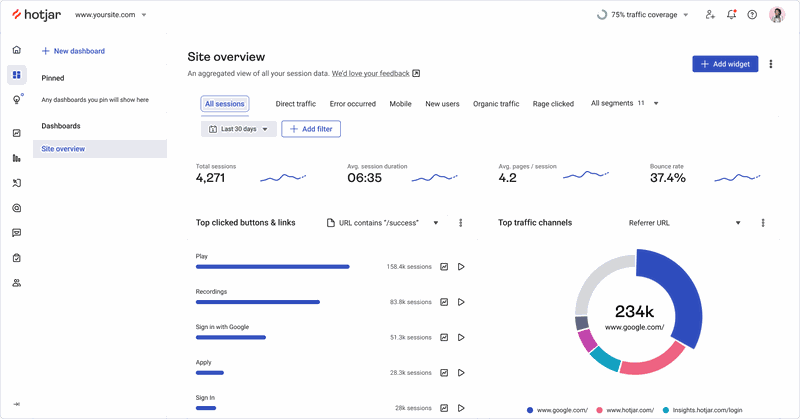
Standout features:
- Heatmaps and session recordings for user behavior analysis.
- On-site and in-app feedback widgets (NPS, CSAT).
- Real-time polls for quick user input.
Pros:
- Easy setup for non-technical teams.
- Excellent for UX optimization and friction detection.
Cons:
- Limited targeting options for advanced segmentation.
- Limited, basic reporting.
Pricing:
- Basic: Free forever (up to 35 daily sessions)
- Plus: $39/month
- Business: $99/month
- Scale: $213/month
*You can save 20% if you pay annually.
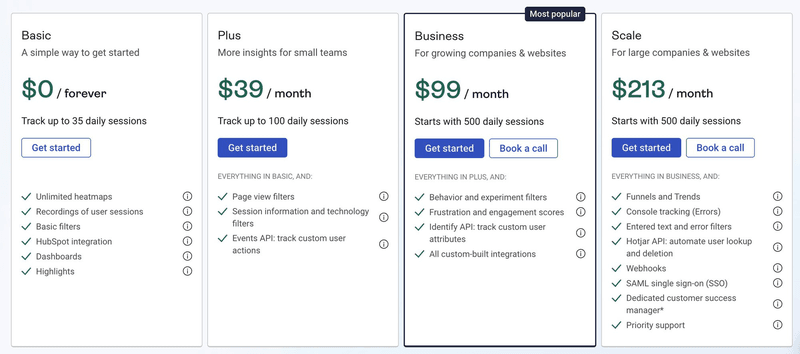
III. Feature request and roadmap platforms
Feature request and roadmap platforms help you collect user ideas, prioritize feature requests, and share product roadmaps transparently. Here are the ones I consider the best.
9. Canny: Best for public feature voting boards
Best for: SMB and mid-market SaaS companies that want a simple, transparent way to collect feature requests and share roadmaps with their users.
| Overall Canny G2 rating | 4.6/5⭐️ |
|---|
Canny helps you gather feature ideas from customers, prioritize them based on votes, and maintain public roadmaps to improve transparency. It’s perfect for teams that need a no-code solution to manage the feature feedback loop effectively.
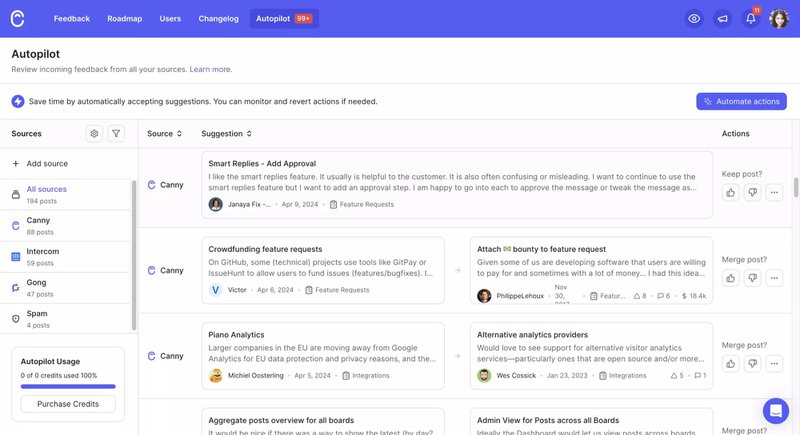
Standout features:
- Public boards for feature submissions and upvoting.
- Product roadmap display linked to real user feedback.
- Integrations with Slack, Intercom, and Zapier for workflow automation.
Pros:
- Easy setup, no coding required.
- Helps close the feedback loop with roadmap visibility.
Cons:
- Limited analytics beyond voting trends.
- Users report merging and duplication issues, especially when migrating from another platform.
Pricing:
- Free plan: Up to 25 tracked users
- Core: $19/month
- Pro: $79/month
- Business: Custom pricing
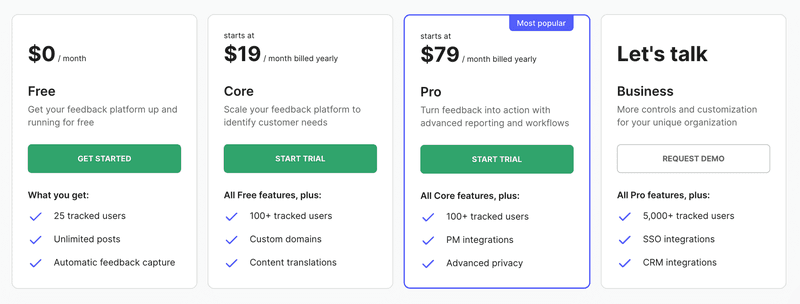
10. Savio: Best for centralizing feedback from multiple sources
Best for: Small SaaS teams that need to aggregate feature requests from different tools like Intercom, Slack, and CRM systems into one organized hub.
| Overall Savio G2 rating | 4.8/5⭐️ |
|---|
☝🏻 Note: Savio’s G2 rating is based on only five reviews.
Savio is built for product managers who want to prioritize feature requests using real customer data without adding complexity. It integrates with support and sales tools, so every piece of feedback flows into a centralized, searchable system.
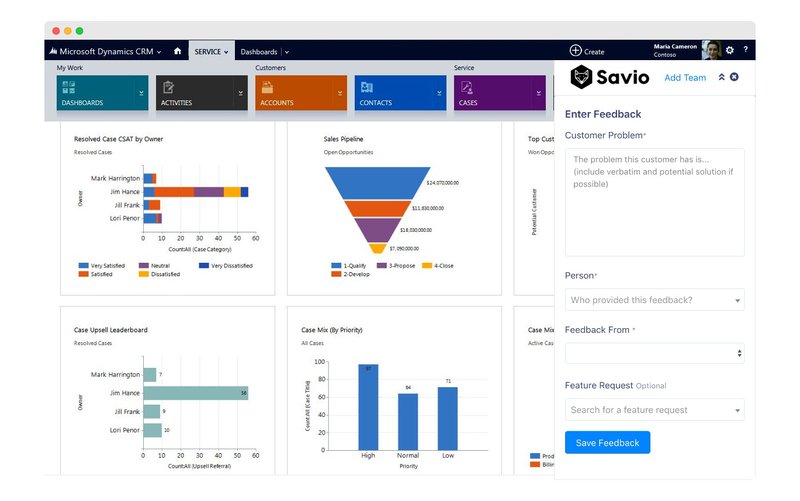
Standout features:
- Feedback collection through integrations with Intercom, Slack, Help Scout, Zendesk.
- Tagging and prioritization with customer context.
- Changelog updates and internal notes to keep teams aligned.
Pros:
- Simple to adopt for lean product teams.
- Strong integration support for customer-facing tools.
Cons:
- No public voting or roadmap boards by default.
- Some users report that it’s not very intuitive.
Pricing:
- Essential: $49/month
- Professional: $99/month
- Business: $299/month
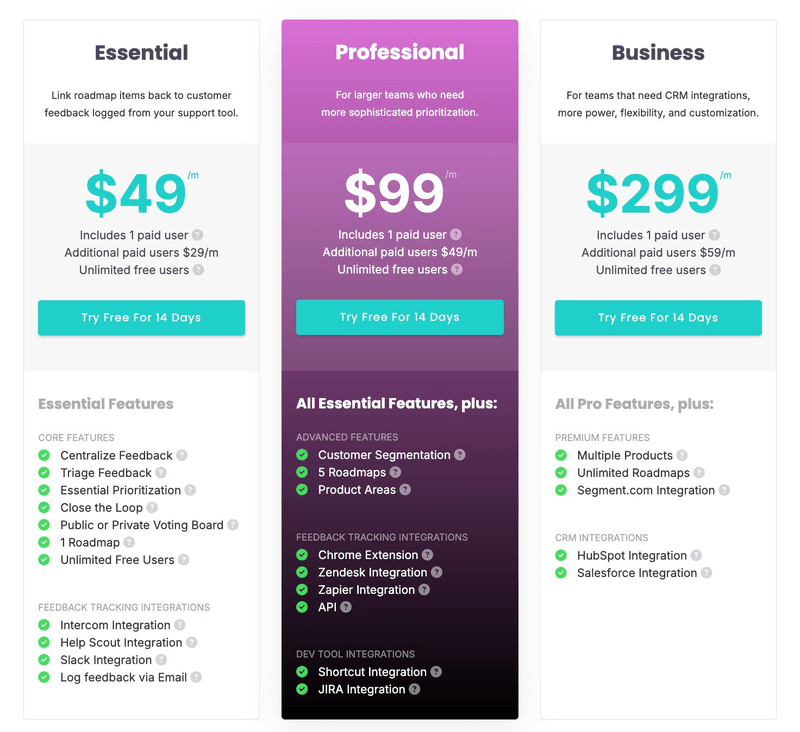
11. Productboard: Best for strategic roadmapping with customer data
Best for: Mid-market and enterprise SaaS companies that need feature prioritization frameworks and advanced roadmap planning in one tool.
| Overall Productboard G2 rating | 4.3/5⭐️ |
|---|
Productboard is a full-featured product management platform that helps teams capture feedback, connect it to feature ideas, and plan roadmaps using prioritization models.
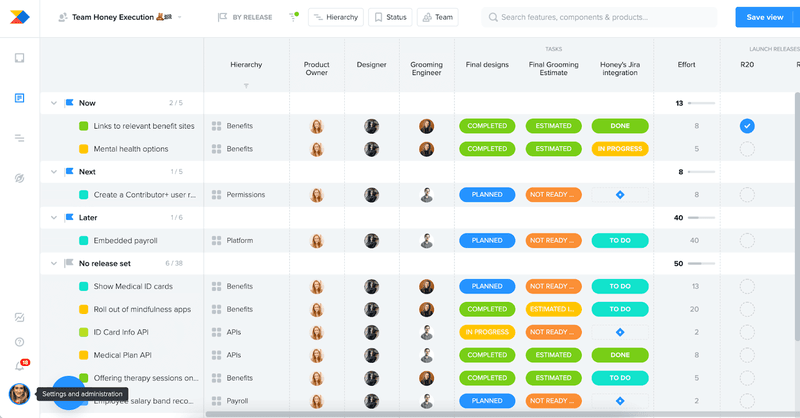
Standout features:
- Feedback portal with customer and sales input consolidation.
- Prioritization frameworks like RICE and custom scoring.
- Advanced roadmap visualization and Jira/Azure DevOps integration
Pros:
- Combines feedback collection with robust product planning tools.
- Excellent fit for distributed or large teams needing visibility.
Cons:
- Steep learning curve for new users.
- Expensive compared to standalone feedback tools.
Pricing:
- Starter: free
- Essentials: $19/month
- Pro: $59/month
- Enterprise: Contact sales for custom pricing
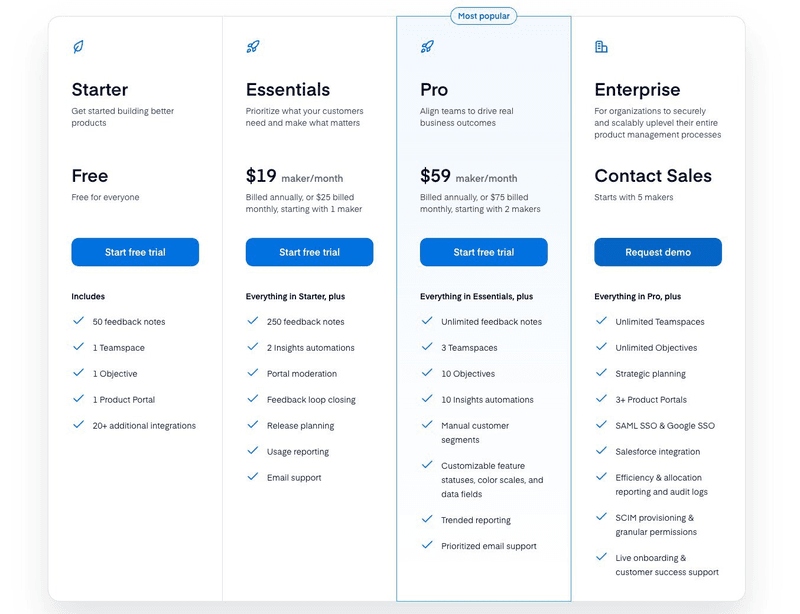
12. UserVoice: Best for enterprise-grade feedback management
Best for: Large SaaS organizations needing secure, scalable feedback and roadmap workflows with compliance requirements.
| Overall UserVoice G2 rating | 4.5/5⭐️ |
|---|
UserVoice is a feedback management platform designed for enterprise environments where security, compliance, and detailed analytics are among the key requirements.
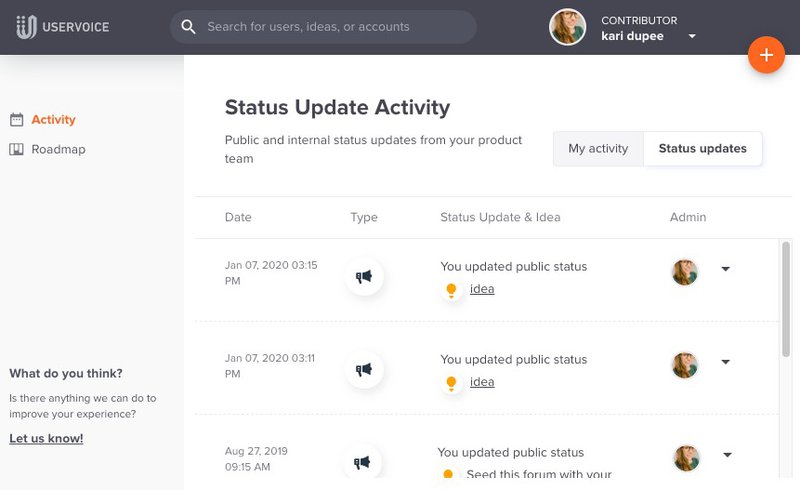
Standout features:
- Advanced voting boards and feedback portals.
- Analytics for trends, sentiment, and customer segmentation.
- Custom workflows and API for enterprise integration.
Pros:
- Highly scalable with enterprise-grade security.
- Strong reporting and workflow customization.
Cons:
- High price for small and mid-market companies.
- Complex automation and interface navigation.
Pricing:
- Growth: $899/month
- Team: $1,199/month
- Strategic: $1,349/month
- Enterprise: Custom pricing
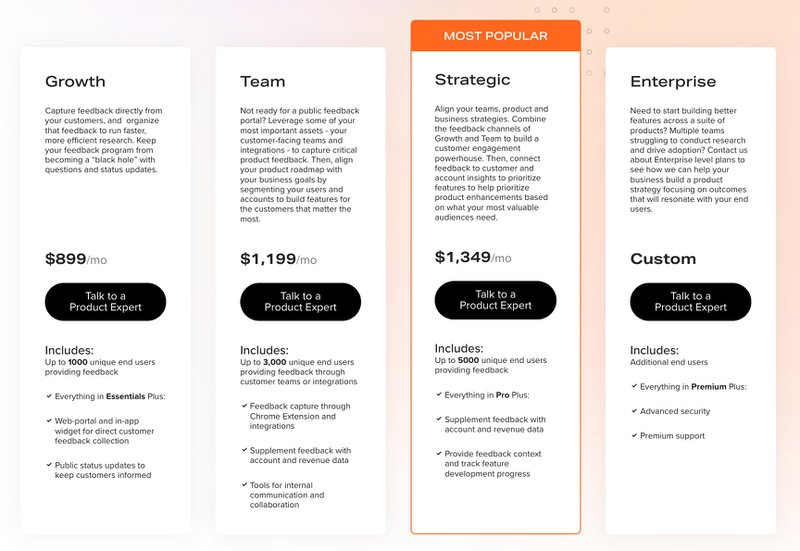
IV. User interview and testing tools
User interview and testing platforms focus on qualitative data through interviews, usability tests, and session replays. My research shows that the following tools are the best:
13. UserTesting: Best for enterprise-scale qualitative research
Best for: Enterprise SaaS and large product teams that need deep user insights through moderated and unmoderated usability testing at scale.
| Overall UserTesting G2 rating | 4.5/5⭐️ |
|---|
UserTesting provides on-demand access to real users for usability tests, concept validation, and video feedback, helping teams uncover the why behind user behavior.

Standout features:
- Moderated and unmoderated testing sessions
- Global participant panel with advanced demographic targeting
- AI-driven highlight reels and sentiment tagging
Pros:
- Rich qualitative data with visual context through screen recordings
- A strong global participant network, so you can test and iterate faster
Cons:
- High cost compared to more lightweight tools from this list, like Maze or Userpilot
- Requires planning for study design and analysis (such as having test scripts ahead)
Pricing:
Prices available on request.
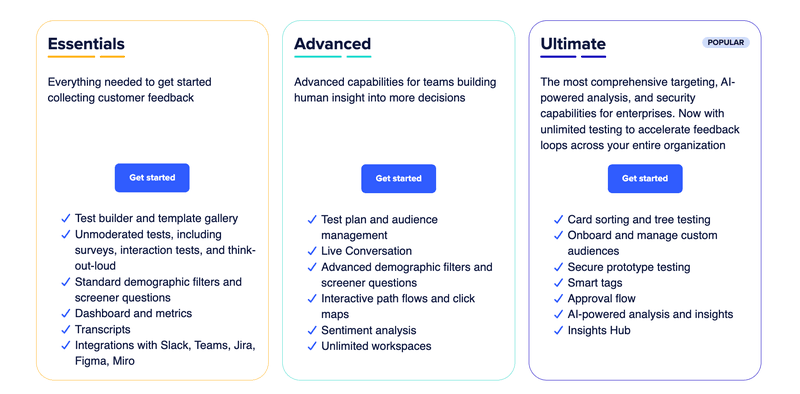
14. Maze: Best for fast prototype testing and idea validation
Best for: Design and product teams in agile SaaS environments that need quick, unmoderated usability tests during sprints.
| Overall Productboard Maze rating | 4.5/5⭐️ |
|---|
Maze is a user research platform that focuses on rapid, remote testing for prototypes and design concepts. It’s perfect for teams that need fast feedback loops without extensive recruitment or setup time.
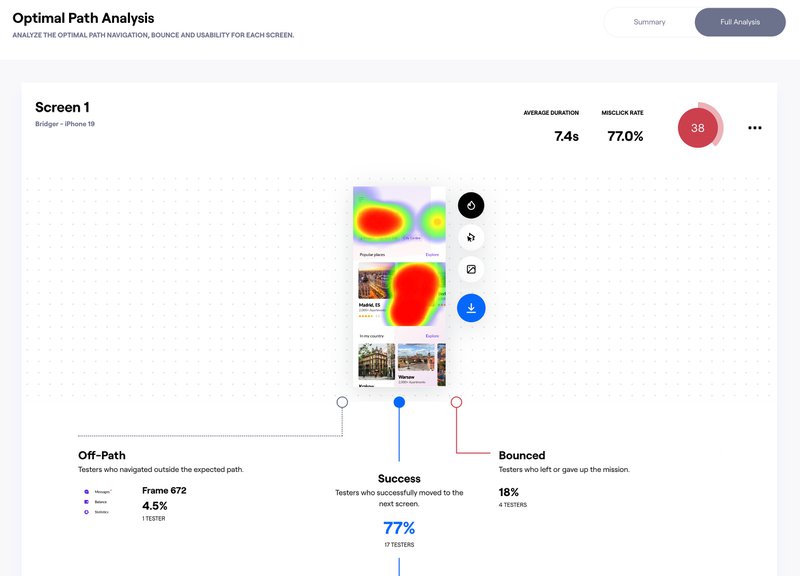
Standout features:
- Clickable prototype testing with heatmaps
- Built-in survey templates and follow-up questions
- Integrations with design tools (Figma, Sketch, Adobe XD)
Pros:
- Quick setup for design validation during development cycles
- Strong visual reporting with task completion data
Cons:
- Limited for post-launch feedback
- Participant pool is smaller than full-service research tools
Pricing:
- Free plan: Limited tests
- Starter: $99/month
- Enterprise: Custom pricing

15. Useberry: Best for affordable prototype testing
Best for: Small SaaS teams and freelance UX designers needing a budget-friendly alternative to Maze for concept validation.
| Overall Productboard G2 rating | 4.3/5⭐️ |
|---|
Useberry offers interactive prototype testing with heatmaps and clickstream tracking. It’s a practical choice for smaller teams that want to validate designs before coding.
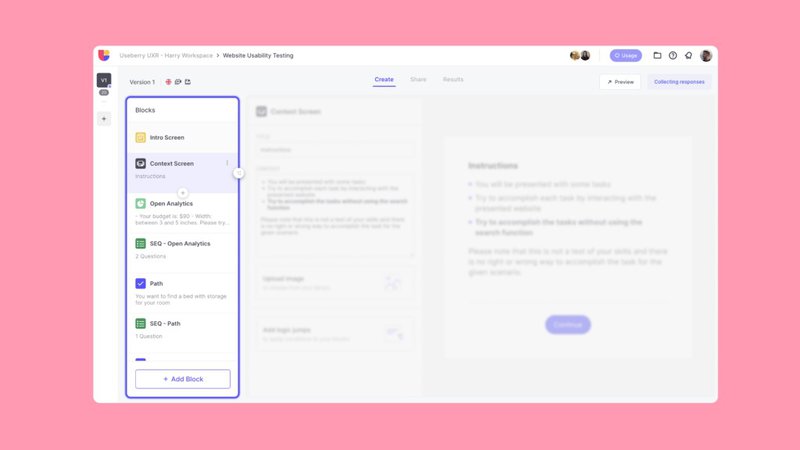
Standout features:
- Task-based prototype testing with visual reports
- Pre-built survey templates for qualitative feedback
- Integrations with major design tools
Pros:
- Lower price point than most UX research platforms
- Easy-to-use interface for quick testing cycles
Cons:
- Lacks advanced analytics and large participant panels
- Not designed for live moderated research
Pricing:
- Free: Up to 10 responses per month
- Growth: $67/month (billed annually)
- Enterprise: Custom pricing
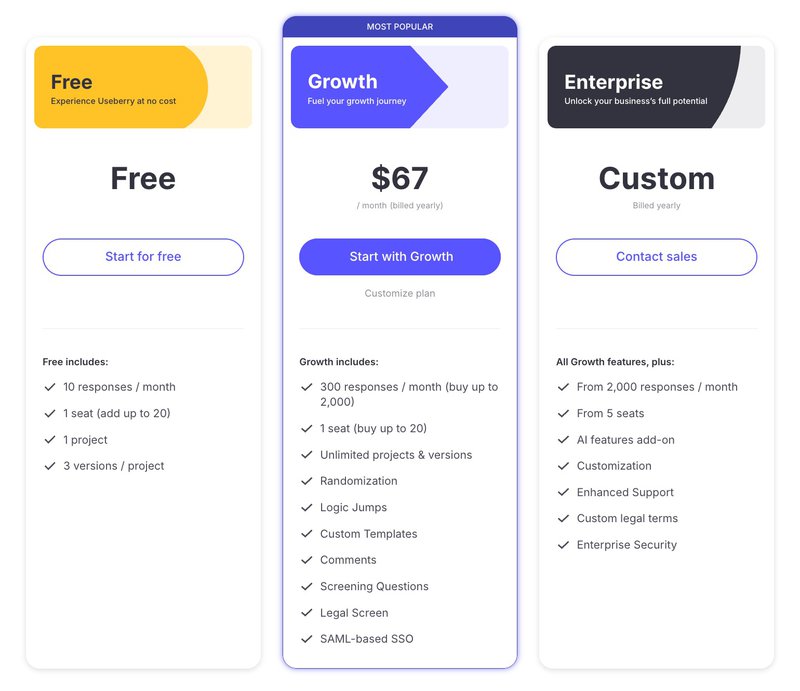
16. Lookback: Best for live moderated user interviews
Best for: Mid-sized SaaS companies looking for real-time user research sessions with collaborative observation features.
| Overall Productboard G2 rating | 4.3/5⭐️ |
|---|
Lookback combines live and unmoderated testing to help teams conduct interviews and usability sessions in real time, complete with timestamped notes and recordings for detailed feedback analysis.
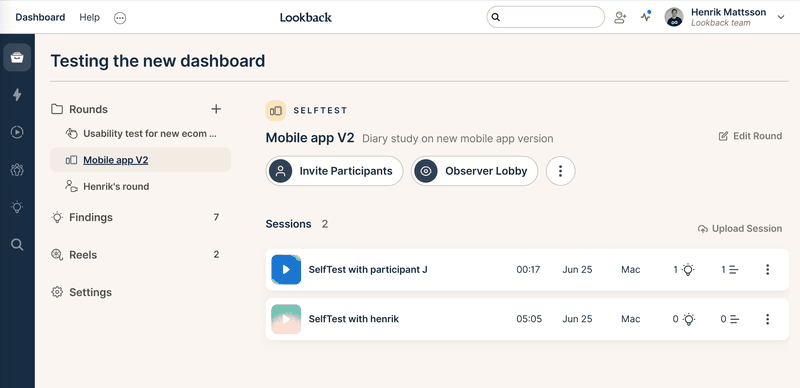
Standout features:
- Live video sessions with note-taking and participant observation
- Remote usability tests with automated recordings
- Team collaboration features for sharing learnings
Pros:
- Provides deep qualitative insights during live sessions
- No need for separate conferencing or screen-sharing tools
Cons:
- Video-heavy sessions can cause performance issues on slow networks
- Complex setup compared to lightweight survey tools
Pricing:
- Freelancer: $299/year
- Team: $1,782/year
- Insights Hub: 4,122/year
- Enterprise: $18,150/year
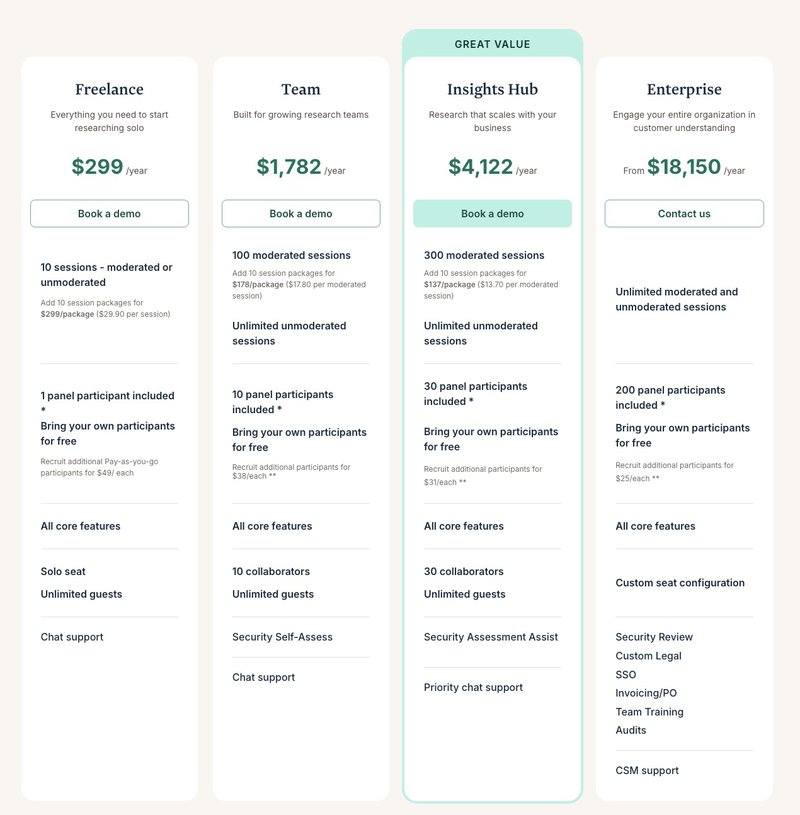
V. Review and social listening platforms
The final category includes tools for monitoring external channels for unsolicited (and often unfiltered!) user feedback. These let you dig deeper into user needs and turn user feedback into takeaways you can implement right away:
17. G2: Best for collecting verified customer reviews and social proof
Best for: SaaS companies of all sizes that want to leverage user feedback for credibility, benchmarking, and insights into customer satisfaction.
| Overall G2 rating | N/A |
|---|
G2 is the leading B2B software review platform, where customers share feedback that influences purchase decisions. For SaaS companies, it’s both a marketing asset for social proof and a data source for uncovering trends in feature requests and user needs.
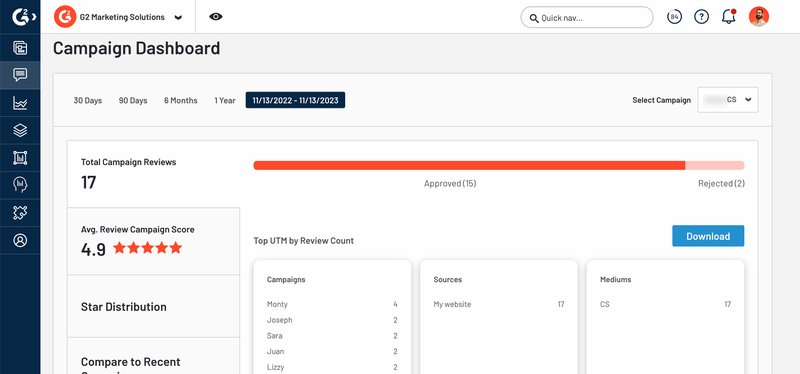
Standout features:
- Verified user reviews with detailed scoring
- Competitor benchmarking and category rankings
- Review syndication for marketing campaigns
Pros:
- Builds trust through authentic user feedback
- Provides insights into customer satisfaction and competitive positioning
Cons:
- Limited ability to collect structured, in-app feedback
- Paid placements and lead gen features can get expensive
Pricing:
- Free: Basic listing with user reviews
- G2 Marketing Solutions: Paid marketing packages have custom pricing

18. Sprout Social: Best for social listening and brand sentiment analysis
Best for: Marketing and customer success teams at SaaS companies monitoring social channels for user feedback and brand sentiment.
| Overall Sprout Social G2 rating | 4.4/5⭐️ |
|---|
Sprout Social helps you track and respond to brand mentions across social media and online communities, turning unsolicited feedback into actionable, strategic takeaways.
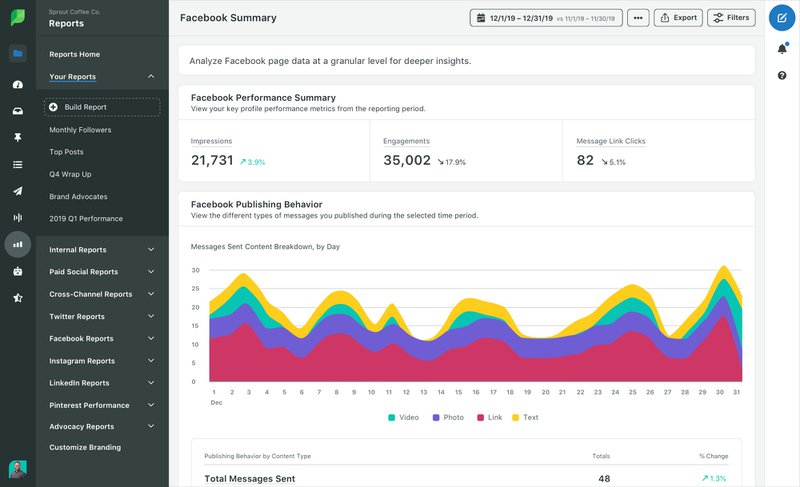
Standout features:
- Social listening dashboards with sentiment analysis
- Competitor benchmarking and trend reporting
- Centralized inbox for managing multiple social channels
Pros:
- Excellent for real-time brand monitoring
- Provides deeper context around user needs and market trends
Cons:
- Limited for structured product feedback workflows
- Pricing scales quickly for teams managing multiple profiles
Pricing:
- Standard: $199 per seat/month
- Professional: $299 per seat/month
- Advanced: $399 per seat/month
- Enterprise: Custom pricing

Close the feedback loop, take a step toward smarter product decisions
Among these 18 options, the right choice depends on your goals and your team’s reality.
Many feedback tools are complex, require you to involve developers, and then take weeks to implement. Others add unnecessary bloat to your tech stack without delivering real value. Our goal here was to help you find a solution that fits your needs without slowing your team down.
Every piece of feedback is a chance to do better and stand out. It’s your direct line to improving customer satisfaction, optimizing onboarding, and making data-driven decisions that support customer retention, revenue growth, and long-term success.
Other platforms can help in specific areas, but if you want an all-in-one solution without extra tools and fragmented data, Userpilot has got you covered.
Start listening, start learning, and start building the experiences your users deserve. If you’re ready to do that, book a demo with Userpilot and see how easy it is to collect, analyze, and act on user feedback, all in one platform.
FAQ
What are feedback platforms?
Feedback platforms are tools that help you collect, manage, and analyze user feedback in one place. They support multiple channels like in-app surveys, NPS, feature request boards, and social listening. The goal is to turn customer feedback into key learnings that guide smarter product decisions and improve customer satisfaction.
How much does UserVoice cost?
UserVoice offers custom pricing for enterprise plans, while basic plans typically start around $899/month. The cost varies based on features like feedback management, advanced reporting, and integrations.
How much does Usersnap cost?
Usersnap pricing starts at $69/month for basic feedback capture and goes up to $249/month for plans with advanced features like visual feedback, surveys, and integrations.

